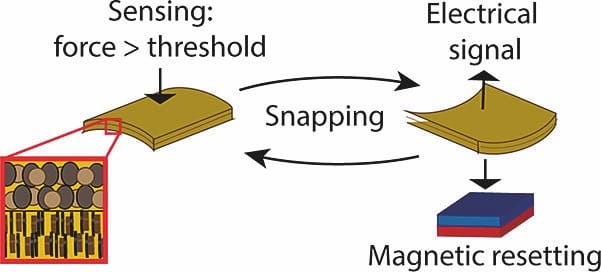Snap! Goes the Future…
Natural innovations: New research shows how far the development of biomimetic sensors has come and the potential they have for mimicking real-life nervous systems

Have you ever played with one of those snap wristbands when you were younger?” Andres Arrieta asks. In the Engineering lab at Purdue University, Dr Arrieta and his team have designed a novel data sensor that uses a similar snap-change; from a curved shape that is under tension, to a flat structure which generates an electronic signal when triggered. The latest in the field of biomimetic sensors, this sensor has the potential to function like a real-life nervous system.
In their flat form, the sensor’s two layers are held apart. Then, when an impact triggers a snap-change by a clever trick of engineering, the layers are brought together, allowing tiny flecks of nickel that are spread throughout the top layer to become close enough to conduct an electrical signal. A magnet in the bottom layer resets the switch.
“The shape is encoding the message,” says Dr Arrieta. “It’s just like having ones and zeros in a binary system.” And he’s right: the two shapes translate into a binary ‘1’ and a ‘0’, allowing the sensor to generate a simple string of data. Biomimetic developments like these, taking inspiration from nature, have revolutionised fields that rely on data-sensors such as automotive technology and robotics.
The advanced, yet mildly terrifying Cheetah robot at the MIT Biomimetics lab uses similarly novel biomimetic sensors in the Cheetah’s footpads. The limiting factor in advancing robotics to reflect human actions is not a mechanical problem, but one of data-sensing. Data-sensors need to capture a complex amount of data, process this in real-time, and yet be made of lasting, durable materials.
Biomimetic units like these completely redesign data-sensing. Current digital models improve sensitivity by upping the data input, relying on a sophisticated processing unit to sift through the volumes of information. But nature has already found a more efficient answer; filtering at the point of data sensing, triggering a signal only when past a set threshold. This means Dr Arrieta’s unit only snaps when it should, and ignores the background noise. Yet, Dr Arrieta explains, this still doesn’t explain the full potential of the research. Copying biology brings more advantages than just efficiency; Mother Nature has also worked out how to handle truly complex data, including non-binary data.
Dr Arrieta uses the example of a bird’s flight to explain this; nerves in the bird’s wings are sensitive to the angle of each feather and how they move in the wind as the bird flies. The extent of change to this angle determines the action the bird takes; a subtle ‘wingtip’ adjustment for a light breeze, or a bigger movement needed for a heavy gust. This unit, just like a bird’s wing, also has the ability to generate a range of actions.
“Our signals can be interpreted in ‘ones’ and ‘zeros’, so ‘on’ and ‘off’. But also - and this is really the power of it - every time there is a snap, there is a pulse of electricity. Binary logic has only a ‘one’ and a ‘zero’, but our [unit] works with pulses of information. So, depending on how fast, slow, strong, or weak the sensor is triggered, the pulse pattern will be different, and our unit interprets these differences.”
These unique electrical patterns can be mapped to a learning algorithm, which translates these signals into various actions. This brings the potential of the system closer to a real-life nervous system – completely different from digital data-sensing.
So, it’s different - but is it really that much better than digital methods? Daniel McKenna, a robotics software engineer at the artificial intelligence start-up Emotech, thinks that both digital and biomimetic sensors have their pros and cons. He does, however, point out that while developers have now designed processors that can handle huge amounts of digitally generated data, overcoming past limitations, there is a recent “drive to simplify things”. “There’s a push to try miniaturise things, move them back onto devices while avoiding battery drain, rather than relying on the cloud servers that enable large amounts of processing power. These sensors would filter unnecessary information and lead to faster on-machine processing.”.
Asked to explain if Dr Arrieta’s excitement over the potential to read unique electrical signals may be warranted, McKenna points to his own analogy. Referring to data like this as non-linear, he describes water in a bucket responding to vibrations. The water converts a time differentiated input (the beat of the vibrations) into a spatial signal (the pattern of ripples seen in the water), at a much quicker speed than an algorithm could. Likewise, the electrical pulse translates data at a much quicker speed than a digital sensor would. “The processing that biomimetic sensors offer gives that element of non-linearity a lot easier than a digital system,” he notes.
But before starting a wristband-wearing, mechanical cheetah-wielding robotics revolution, McKenna warns it will need hours of testing before it goes to market due to the high-stake safety implications. But despite a long road ahead, it’s come a long way from a simple snap-band toy. Don’t you think?








